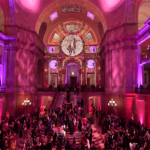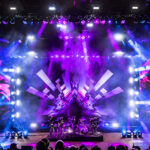French electronic music pioneer Jean-Michel Jarre has very nearly done it all. Born in Lyon, France, son of film composer Maurice Jarre, Jean-Michel began studying classical music at an early age and formed his first major rock band in the late 1960s. Within a few short years Jarre had tapped cutting-edge keyboard technology and helped to revolutionize synthesized music with releases such as 1976’s global hit Oxygène, 1978’s Équinoxe, and 1981’s Les Chants Magnétiques.
As Jarre’s music grew in complexity, so did the artist’s theatrical ambitions. By the late 1970s Jarre traversed virgin territory, undertaking tours and dazzling massive crowds with one-off live production extravaganzas.
He’s performed at the base of the Great Pyramids at Giza in Egypt. He was the first Western music figure of note to stage a concert in the post-Cultural Revolution China, and more recently appeared at Masada, Israel, near the Dead Sea. He’s broken attendance records all over the world for outdoor concerts, including an event in 1986 in Houston, TX that drew 1.3 million spectators, earning him an entry in the Guinness Book of World Records.
This year, Jarre notched up more achievements, including another spectacular one-off mega-concert production. On April 6, 2017, Jarre performed near Masada, Israel, in the hopes of raising awareness for the “slow-motion crisis” taking place at the neighboring Dead Sea (Photos of the Masada show appear throughout this article; for more info on that event, see, see sidebar, below).

North American Tour Design
In May 2017, Jarre embarked on a tour of North America, with performances in New York, Toronto, Boston, Chicago, Los Angeles and other cities.
“When I was 18 years old, I walked into Radio City Music Hall and I remember thinking to myself, ‘One day I’ll play here,’” Jarre tells PLSN. “I did lots of different projects in America, but I’ve been more involved in one-off productions. This tour is quite special to me personally and in terms of concept.”
Most electronic music is inherently visual, but Jarre’s stage presentation is a veritable symphony of synchronized images and sound.
Cinematic spectacle is complemented by a musical narrative flush with ghostly synth lines, sequenced rhythms, quavering cosmic sirens, whistling whirly noises, and manipulated voice samples that penetrate our psyches in ways only electronica can.

Jarre tends to envision an entire production, or the seeds of an entire production, even as he composes and records in his studio. His current tour is no exception. “I was influenced by Jackson Pollock when I was a student, and I always thought electronic music is very close to abstract painting,” says Jarre. “I wanted to express visually how I am approaching music composition or mixing by creating architecture of sound and soundscapes…”
Designs for the tour developed in some very unconventional, if effective, ways. “I started on my own by designing everything on computer, using WYSIWYG, and also a piece of paper,” says Jarre. “For every track, I decided on what kind of graphic direction I’d like to go. Then I worked with different people, like lighting designer and director Jvan Morandi. He’s a great guy; an Italian living in London who works with lots of rock bands, like Placebo, and is designing for operas.”
Jvan Morandi, of Placing Shadows Lighting and Show Design, notes that Jarre “tends to sketch stuff, and then we start talking about it. I was bouncing ideas back to him, and he was sketching on anything that is valuable to him at the moment. If he’s in a pizza parlor in San Francisco, he’ll put two slices together, take a picture, and send it to me as some kind of visual example of what he’s thinking. Then we do a mockup and transfer this idea into…WYSIWYG.”
Jarre often operates from what seems a bottomless well of energy and creativity. It’s both exhausting and exhilarating for those on his production team. “The man is 68, and he will kill both me and you,” says Morandi. “A lot of discussion happens in what we call our ‘Dracula Hours’ calls. We would be communicating via phone or Skype around midnight until three or four in the morning. These calls were at the core of the success of this production, in a sense. He keeps on working, and always remains very kind and polite.”

3D Effects from Mobile Screens
One of the main visual ingredients of the Jarre show is the 3D effect created through the use of multiple layers of mobile, transparent, low-res LED screens. Claypaky Stormy CC fixtures bolster the overall impact of the lighting, but the ROE Creative Linx-30 curtains are at the heart of the show’s mind-altering optical illusions, what audiences perceive as objects floating in three dimensions. (PRG Europe and PRG America supplied the LED screens and lighting, respectively).
“I conceived of something very special for the tour: 3D effects without the use of 3D glasses,” says Jarre. “As an artist you’re always trying to explore through technology.”
“Generally speaking, this is a video installation show, in which the lighting takes a step back in many songs,” Morandi says. “There’s just key lighting for the performers and for accents. In some songs, the lighting does jump to the foreground with timecoded effects, and the LED screens can be used for lighting as well. Tracks like ‘Web Spinner’ use the full brightness of the LED screens to create color fields and strobing…”
“For ‘Web Spinner,’ we’d decided to not use the screens as lighting panels,” says lighting programmer and operator Jordan Babev. “I did a breakdown of the track, and following the sequence of noises I’ve tried to alternate monochromatic lighting panels with a matrix of lights [positioned behind the panels]. The screens are constantly moving, creating dynamic walls. The artist appears as though he is inside a box that opens and closes.”
The Linx-30s can move from stage left to stage right, and from either end to center stage. When the screens are static at center stage, Jarre performs from behind a veritable curtain of panels, upon which programmed images appear in shapes ranging from a cube to a revolving Earth-like sphere morphing into a human skull (reminiscent of the iconic Oxygène album cover).
“We are creating layers through transparency,” says Morandi. “The original idea for the show emerged from a concept of a rotating sphere on stage. You still get a sense of rotation, this sphere rotating, like lines passing between the foreground and background. We’re always on the edge of the Moiré effect.”

Track Bandits
Without the elegant mechanics of the Wahlberg’s motorized DMX-controlled track runners, Jarre’s extravagant North American production would literally grind to a halt. Shuttling the LED screens to and fro, gliding along standard lightweight aluminum tracks, these bandits (each weighing 23 pounds) perform an almost indispensible job.
Initially, the idea was to have each LED screen independently rotate 360 degrees. “[Applying the rotating design] was postponed, and the production decided that for the summer tour [in 2016] they wanted only the straight movement of the screens,” says Mads Wahlberg, CEO of Wahlberg Motion Design of Denmark. “We could make the screens rotate, if we wanted, but [the production team] felt the movements were working so well even without the rotation.”
The track runners are programmed to move to certain key positions and run at different speeds. “It’s been very straightforward to program [the Wahlberg track runners],” says Morandi. “Everything is timecoded. The system has proven to be very reliable.”
“Every single motor behaves like a lighting unit — a very basic one,” adds Babev. “Once the zero points are done, it’s a fixture with one channel for the position on the track and one channel for the speed. Every song is based on one or more positions of the screens. Every motion cue is triggered via timecode LTC, which we’re using for lighting and video as well.”

The Laser Harp
When it comes to his live productions, Jarre is nothing if not hands on. Literally. A MIDI device dubbed the Laser Harp, a signature visual centerpiece of Jarre’s show for decades, has both dazzled and perplexed observers. Fans will recognize this as the piece of equipment Jarre uses in the song “The Time Machine.”
In a nutshell, every time Jarre breaks the beams, or a beam, streaming from his Laser Harp, this action triggers (via MIDI) an event on a synthesizer. To help illuminate the operational details of Jarre’s Laser Harp we reached out to Justin Perry, chief operation officer at Pangolin Laser Systems, Inc., manufacturer of the Beyond laser control and multi-media software system Jarre uses on tour.
“There are some misconceptions about Jarre’s Laser Harp,” says Perry. “The classic laser harp that general consumers buy is not what Jarre has. His harp is intuitive. When he breaks the beam it will execute a function, just like a normal laser harp. However, as he moves his hand up or down within the laser beam, that creates additional effects. In our Beyond software, there’s a tool called ‘scripting.’ Scripting allows the user to write a custom code command. If you break the laser beam and want to trigger, say, a burst effect, you can do that. That’s what they’re doing on Jarre’s tour.
“The harp communicates with our Beyond software, which sends a signal to our FB4 media server inside the projectors,” Perry adds. “Inside every laser projector is a motor called an optical scanning system, which we now manufacture. Laser Image, out of the Netherlands, built our FB4 media server into their projectors. The FB4 supports all major lighting and laser protocols, network DMX, Art-Net, OSC timecode, the old school laser protocols, like ILDA … It also has onboard SD card memory, so regardless of how an individual wishes to control the lasers, be it from a console, computer, or a laser harp, which is what Jean-Michel Jarre does, they can do that. An Art-Net feed is going to the back of the lasers, and our software is running on a PC in the background. [Jarre is] able to control and manipulate content in real time from the grandMA2.”

Control
All of the movement — lights and screens, even lasers — can be controlled by one lighting desk, but the production designers thought it best to split the operations.
“For safety and margin of error purposes, we moved the automation onto a separate lighting controller,” says Morandi. “A grandMA2 controls the automations. We control lights and media servers — Catalyst V5 — via a ChamSys MQ500. The lasers are all on timecode and networked and controlled by our systems. The Catalysts control an array of custom-made Blackmagic panels for switching for all the robotic cameras, lipstick cameras and iPad cameras dotted around the stage. We even have micro-cameras in [Jarre’s] glasses. All systems are synced via SMPTE timecode generated by the Ableton audio system on stage.”
“The two grandMA2 desks are located at front of house and on stage, and use the MA Net network protocol,” says Babev. “However, only the one on stage is sending data to the actual screens via the physical DMX output. The reason behind this is safety: at any time, we can stop the screens.”
Morandi explains that programming for the tour was “murderous” and required the team to work around the clock over a four-week time period. Despite the strict adherence to timecode, designers managed to carve out moments of “planned” spontaneity. “We have breaks in the timecode flow to allow for Jean-Michel to talk to the audience and decide every night to keep the show more personal to each of the city,” says Morandi.
“I spend so much time during sound check, trying to twist every night into something different,” says Jarre. “The crew generates a good show but … because everybody is quite happy and relaxed after a good show, that could become dangerous. By making this an evolving project, it keeps everyone edgy, you know?”
The Jarre crew worked tirelessly and cohesively to get the production off the ground. Show prep for the 2016 tour — the basis for his 2017 dates — lasted six months. Weeks of rehearsals followed.
“It was important for everybody to be in sync for the rehearsal,” Jarre says. “The sound engineer has to understand what we are doing visually. Everyone, from the guy doing the backline to those taking care of scaffoldings — they should know what final results I’m aiming for. Everybody knows what they are doing, and why they are doing it.”

Salt of the Earth: Jarre in Israel
he Dead Sea in Israel is the lowest body of water on the planet, if not one of the saltiest. Scientists estimate that the Dead Sea may be completely depleted of its scant supply in the next few decades. Although some geologists challenge this assertion, the Sea’s water level will likely remain dangerously low for the foreseeable future.
Further exacerbating tensions is the fact that everyone in the area — Israelis, Palestinians, Jordanians and Syrians — needs water. Damming off resources from the River Jordan and other tributaries has done little but strain already sensitive political situations. On April 6, 2017, prior to his North American tour, Jarre staged one of his famous one-off mega-concert productions at Masada, Israel, in the hopes of raising awareness for what the BBC in 2016 called a “slow-motion crisis.”
Ironically, environmental concerns — aside from the obvious water shortage — helped shape the Jarre concert. Tour vets will tell you that working outdoor festivals is one thing: working open-air shows in the middle of a desert is another. Allowing expensive gear to sit in the salt-rich environment of the Dead Sea, for days, as the build occurs would result in equipment malfunction or worse. As a result, the production was supplied gear through local companies. Problem?
“We had to use nontransparent screens,” says lighting designer Jvan Morandi. “I realized that we could compensate a little for the lack of transparency in trying to attain a little bit of a 3D effect. We had thin strips of high-resolution screens with gaps in between.”
Various obstacles did not prevent the show from being an artistic success. Visually it proved to be stunning. Nestled into topography of the site — oceans of sand and a towering 500-meter tall cliff — looked like “a little crystal city in the middle of the desert,” says Morandi. “It’s like salt crystals coming out of the sand. Maybe even a ‘letter box’ within the desert.”

Jean-Michel Jarre Support Team
Crew
Lighting Designer: Jvan Morandi, Placing Shadows Lighting and Show Design
Lighting Programmer/Operator: Jordan Babev
Lighting/Video Co: PRG
Lighting and Video Crew Chief: Vincent Ex
Lighting Crew: Jason Winfree, Charles Collins
Catalyst and Video Racks: Maarten Quirynen
Video Tech: Jeroen Mahieu
Lasers: Hugo Bunk, Laser Image The Netherlands/Australia
Motion Operator: Joeri Pluym
Management: Aero Productions
Tour Manager: Chris Rowley
Production Manager: Kevin Hopgood, Pull the Pin Out Productions

Gear
- 1 ChamSys MQ500 (for lighting and video)
- 1 grandMA2 Light (for motion control)
- 35 Martin MAC Viper Profiles
- 30 GLP impression X4s
- 50 Claypaky Stormy CCs
- 6 Claypaky A.leda B-Eye K20s
- 224 Square meters ROE Linx-30 (30mm LED screen)
- 1 Catalyst V5 system (for video)
- 2 21m sections of aluminum track
- 10 Wahlberg track runners
- 13 Supernova HD 35W ROGCB OPSL low divergence lasers* (w/Pangolin FB4 Media Server inside)
- 1 20W Laser Harp*
- 16 RGB grating box**
* All lasers made by Laser Image
**A previously posted version of this article included incorrect info for this item. It has been corrected. PLSN apologizes for the error.



